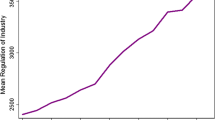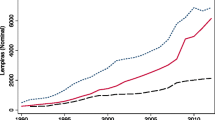Abstract
We analyze how wage arrears are affected by the worker’s type (in this paper, the worker’s type means the worker’s attitude to wage arrears). Wage arrears cause workers’ negative emotion which may lead to serious social problem and the government may intervene. In this paper, we model the process of wage arrears as a Markov decision process in which the firm is the decision maker. We develop an optimal solution approach under the assumption that the worker’s negative emotion threshold (The worker’s negative emotion increases monotonically with increasing back pay. Once the cumulative back pay exceeds a particular value, the worker will take legal actions and the government will intervene. We define the particular value as the worker’s negative emotion threshold.) is normally distributed and provide insights into how wage arrears vary with the worker’s type and the government intervention. We propose the optimal government intervention which stops wage arrears and does not disturb the normal order of the market economy. We show that the intervention depends on the worker’s type and the results imply that the government intervention should be adjusted dynamically according to different regions, industrial sectors and time periods.
Similar content being viewed by others
Notes
This assumption makes sense, considering that workers’ attitude to wage arrears is usually affected by many factors, such as the labor skill, industry, region, race, gender, age, seniority, and so on.
As no similar model can be used for reference except for the one in our unpublished paper, we must occupy a little space to describe the basic model.
According to the \(3\sigma \)-rule, about 99.73 % of values drawn from a normal distribution are within \(3\sigma \) away from the mean \(\mu \). This implies that the threshold is almost impossible to be negative as long as the values of \(\mu \) and \(\sigma \) are reasonable to make \(\mu -3\sigma \ge 0\). Although statistical data is rather sparse, we can almost surely think that \(\mu -3\sigma \) is nonnegative due to the fact that the worker is not likely to take legal actions against the firm without being deducted in real life. Actually, in developing countries, many workers will not take legal actions even if wage arrears happen, unless the unpaid is too much to tolerate. The possibility that the firm pays more than the agreed wage once the penalty is sufficiently high will be also considered in this section.
It also suggests that ’\(\mu >0\)’ is reasonable.
\(x^*\) can be considered as a continuous function of \(\sigma ^2\).
References
Boyarchuk D, Maliar L, Maliar S (2005) The consumption and welfare implications of wage arrears in transition economies. J Comp Econ 33:540–564
Brainerd E (2002) Five years after: the impact of mass privatization on wages in Russia, 1993–1998. J Comp Econ 30:160–190
Chen F, Song J (2001) Optimal policies for multiechelon inventory problems with Markov-modulated demand. Oper Res 49(2):226–234
Chevalier P, Lamas A, Lu L, Mlinar T (2015) Revenue management for operations with urgent orders. Eur J Oper Res 240:476–487
Dimitrov NB, Dimitrov S, Chukova S (2014) Robust decomposable Markov decision processes motivated by allocating school budgets. Eur J Oper Res 239:199–213
Earle JS, Sabirianova KZ (2002) How late to pay? Understanding wage arrears in Russia. J Labor Econ 20(3):661–707
Gerry CJ, Kim B-Y, Li CA (2004) The gender wage gap and wage arrears in Russia: evidence from the RLMS. J Popul Econ 17(2):267–288
Greenfield G, Pringle T (2002) The challenge of wage arrears in China. ILO Labor Education
Grosfeld I, Senik-Leygonie C, Verdier T (2001) Workers’ heterogeneity and risk aversion: a segmentation model of the Russian labor market. J Comp Econ 29:230–256
Gunderson M (1989) Male–female wage differentials and policy responses. J Econ Lit 27(1):46–72
International Labour Office (2008) Global Wage Report 2008/09. ILO, Geneva
International Labour Office (2010) Global Wage Report 2010/11: wage policies in times of crisis. ILO, Geneva
Lehmann H, Wadsworth J, Acquisti A (1999) Grime and punishment: job insecurity and wage arrears in the Russian Federation. J Comp Econ 27:595–617
Li H (2011) Causes and governance of the migrant workers salary arrears problem—the case of migrant workers salary arrears in construction industry and its legal relief. Hebei Law Sci 29(7):26–37
Liu W, Yang L, Liu K (2014) A quantitative analysis on wage arrear governance. Working paper
Puterman ML (1994) Markov decision processes: discrete stochastic dynamic programming. Wiley, New York
Wang Y (2013) Study on the relationship between the crime of refusing to pay labor remuneration and treatment of wage arrears. Crim Law Rev 3:399–415
Wu Y (2013) A thinking about the malicious arrears of wage crime. Leg Syst Soc 24:96–97
Xu J (2006) Legal thoughts on the construction of China’s wage protection system. Acad J zhongzhou 5:82–86
Zeng Y, Liu Y (2010) To be cautious to criminalize owing debt. Law Sci Mag 9:82–85
Zhao X (2013) On Japan’s enterprises payment of the back pay law and its enlightenment. Contemp Econ Jpn 5:85–94
Zhu K, Thonemann UW (2004) Modeling the benefits of sharing future demand information. Oper Res 52(1):136–147
Acknowledgments
The work was supported by the National Science Foundation of China No: 11271356, 71390334, 41401174 and 11501316.
Author information
Authors and Affiliations
Corresponding author
Appendix
Appendix
Proof of Theorem 1
Note that \(\frac{(x+P)(x-\mu )}{\sigma ^2}-2=0\) has two distinct solutions
then for \(x<x_1\) or \(x>x_2\), we have \(G^{''}(x)>0\), which means \(G^{'}(x)\) is strictly monotone increasing; for \(x_1<x<x_2\), we have \(G^{''}(x)<0\), which means \(G^{'}(x)\) is strictly monotone decreasing. And by \(G^{'}(-\infty )=1,G^{'}(\infty )=0\), we can obtain that for \(x\in (-\infty ,x_1]\), \(G^{'}(x)>1\); and for \(x\in [x_2,\infty )\), \(G^{'}(x)<0\). Hence, there exists a unique \(x^*\in (x_1,x_2)\), such that for \(x<x^*, G^{'}(x)>0\), which means G(x) is strictly monotone increasing and for \(x>x^*, G^{'}(x)<0\), which means G(x) is strictly monotone decreasing. Obviously, G(x) attains its global maximum at \(x^*\).\(\square \)
Proof of Corollary 1
By (3), we have
Differentiating (21) at \(x^*\) with respect to \(\mu \), we obtain
From the proof of Theorem 1, we have
Let us consider the sign of
\(\displaystyle h(x)\triangleq \frac{(x+P)(x-\mu )}{\sigma ^2}-1\) has two distinct solutions:
For \(x<z_1\) or \(x>z_2\), we have \(h(x)>0\); for \(z_1<x<z_2\), we have \(h(x)<0\). Denote
Now we consider the sign of \(G^{'}(z_1),G^{'}(z_2)\) to decide the relative position of \(x^*,z_1,z_2\).
Differentiating \(G^{'}(z_2)\) with respect to \(\beta \), we have \(G^{'}(z_2)\) is strictly monotone decreasing in \(\beta \). And \(G^{'}(z_2)\rightarrow 1-\Phi (1)-\phi (1)<0\) as \(\beta \rightarrow 0\), hence \(G^{'}(z_2)<0\). Note that \(G^{'}(z_1)>0\).
By the property of \(G^{'}(x)\), we obtain \(x^*\in (z_1,z_2)\). Then
Hence, \(\displaystyle \frac{d x^*}{d\mu }>0\).\(\square \)
Proof of Corollary 2
1. Differentiating
at \(x^*\) with respect to \(\sigma ^2\), we obtain
As
then
Moreover,
By the property of \(G^{'}(x)\), we know that \(G^{'}(\mu )\ge 0\) is equivalent to \(x^*\ge \mu \). Hence, by (30) and (23), we have \(\displaystyle \frac{d x^*}{d\sigma ^2}>0\,\) for \(\displaystyle \beta \le \sqrt{\frac{\pi }{2}}\).
2.
Differentiating \(G^{'}\left( \frac{3\mu -P}{4}\right) \) with respect to \(\beta \), we can see that it attains its minimum at \(\beta =\frac{4\sqrt{6}}{3}\) with value 0.0927, and thus \( G^{'}\left( \frac{3\mu -P}{4}\right) >0\).
By (31), we have \(\displaystyle G^{'}(\mu )<0\,\) for \(\beta >\sqrt{\frac{\pi }{2}}\). By the property of \(G^{'}(x)\), we obtain \( x^*\in (\frac{3\mu -P}{4},\mu )\,\). \(\square \)
Proof of Corollary 3
The proof is similar to that of Corollary 1.\(\square \)
Proof of Corollary 4
From the proof of Theorem 1, we know that
Then for \(P\ge \frac{1-F(0)}{f(0)}\), we have \(x^*\le 0\).\(\square \)
Proof of Proposition 1
For the given \(\sigma ^2\), differentiating (5) with respect to \(\mu \), we obtain
\(\square \)
Proof of Proposition 2
For the given \(\mu \), differentiating (5) with respect to \(\sigma \), we obtain
It is clear that for \(\sigma \rightarrow 0,\frac{d P^*}{d \sigma }\rightarrow -\infty \) and for \(\sigma \rightarrow \infty , \frac{d P^*}{d \sigma }\rightarrow \sqrt{\frac{\pi }{2}}>0\). \(\square \)
Proof of Theorem 2
First we prove (36) by mathematical induction. For \(t=1,\ldots ,N\),
where \(c_t\) only depends on \(r,w,k,\delta ,\mu _t,\sigma _t^2,P_t,\ldots ,\mu _N,\sigma _N^2,P_N\).
By (12), we obtain
Denote \(v=b+a\) and let us consider \(G_N(v)=r-w+v-(P_N+v)F_N(v)\). Differentiating \(G_N(v)\) with respect to v, we have
Through the proof of Theorem 1, we know that there exists a unique \(v_N^*\in (v_{1,N},v_{2,N})\) such that \(G_N^{'}(v_N^*)=0\) and \(G_N(v)\) has a maximum at \(v_N^*\). Here \(~v_{1,N},v_{2,N}\) are the only two solutions of \(G^{''}(v)=0\), satisfying
Denote
then \(a_N^*((1,b))=v_N^*-b\) is the firm’s optimal decision in state (1, b) at time N. It is uniquely determined by \(G_N^{'}(b+a)=0\) and
By (41), it is clear that \(c_N\) only depends on \(r,w,\mu _N,\sigma _N^2,P_N\). Then (36) holds for \(t=N\).
Suppose (36) holds for some \(t+1(t<N)\), we have
Then
\(\frac{(v-\mu _t)([1+\delta (k-1)]v+\delta c_{t+1}+P_t)}{\sigma _t^2}-2[1+\delta (k-1)]=0\) has two distinct solutions:
where
Similar to the proof of Theorem 1, we can obtain there exists a unique \(v_t^*\in (v_{1,t},v_{2,t})\) such that \(G_t^{'}(v_t^*)=0\) and \(G_t(v)\) has a maximum at \(v_t^*\).
Denote
then \(a_t^*((1,b))=v_t^*-b\) is the firm’s optimal decision in state (1, b) at time t. It is uniquely given by \(G_t^{'}(b+a)=0\). By (12), we have \(M_t((1,b))=\delta \left[ (k-1)b+c_t\right] \). Since \(v_t^*\) only depends on \(r,w,\delta ,k,\mu _t,\sigma _t^2,P_t,c_{t+1}\) and \(c_{t+1}\) only depends on \(r,w,k,\delta ,\mu _{t+1},\sigma _{t+1}^2,P_{t+1},\ldots ,\mu _N,\sigma _N^2,P_N\) as to the assumption, by (47) \(c_t\) only depends on \(r,w,k,\delta ,\mu _t,\sigma _t^2,P_t,\ldots ,\mu _N,\sigma _N^2,P_N\). Thus (36) is proved.
From the above, we obtain that for \(t=1,\ldots ,N-1\), (43) holds. Then the optimal wage arrear policy for the firm is as follows.
Here, \(v_t^*\) is uniquely determined by
Note that (50) contains \(c_{t+1}\), \(c_t\) is obtained from (47) recursively and (47) contains \(v_t^*\), thus \(v_t^*,c_t(t=1,\ldots ,N)\) can be obtained recursively by the following.
\(\square \)
Proof of Corollary 5
From theorem 2, given the state (1, b) at time N, we have
Differentiating it with respect to \(P_N\), we obtain
Through the proof of Theorem 2, we have \(\frac{d a_N^*((1,b))}{d P_N}<0\).
For \(t=1,\ldots ,N-1\),
Differentiating (55) with respect to \(P_t\), we obtain
Also by Theorem 2, we have \(\frac{d a_t^*((1,b))}{d P_t}<0\).\(\square \)
Proof of Corollary 6
Differentiating (36) with respect to \(P_t\), we obtain
By (41), we have
For \(t=1,\ldots ,N-1\), by (47), we have
Obviously, \(M_t((1,b))\) is strictly monotone decreasing in \(P_t\).
Proof of Corollary 7
From Theorem 2, we obtain that \(c_t\) does not depend on b. Then by (36), the result is straightforward.\(\square \)
Proof of Theorem 3
The property of \(G_t^{'}(\cdot )\) in Theorem 2 is the same as \(G^{'}(\cdot )\) in Theorem 1 and the optimal government intervention in period t is the penalty level satisfying \(G_t^{'}(0)=0\).
Proof of Corollary 8
By (2), if the state at time t is (1, b), \(v_t^*=b+a_t^*\) is uniquely determined by \(G_t^{'}(v)=0\).
For \(t=N\), similar to (54), we can obtain \(\displaystyle \frac{d a_N^*((1,b))}{d P}<0\).
Next, we prove: for \(t=1,\ldots ,N\),
By (58), \(\displaystyle \frac{\partial c_N}{\partial P}=-F_N(v_N^*)\), then (60) holds for \(t=N\).
For \(t=1,\ldots ,N-1\), differentiating (47) with respect to P, we have
Then
By the mathematical induction algorithm, we can easily obtain (60) holds for \(t=1,\ldots ,N\).
For \(t<N\), differentiating
with respect to P, we have
Thus, \(a_t^*((1,b))\) is strictly monotone decreasing in P.\(\square \)
Proof of Corollary 9
Rights and permissions
About this article
Cite this article
Liu, W., Liu, K. & Yang, L. A dynamic programming model for effect of worker’s type on wage arrears. Cent Eur J Oper Res 25, 183–201 (2017). https://doi.org/10.1007/s10100-016-0435-x
Published:
Issue Date:
DOI: https://doi.org/10.1007/s10100-016-0435-x




